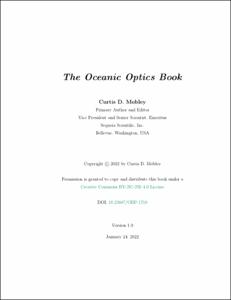| dc.contributor.editor | Mobley, Curtis, D. | |
| dc.date.accessioned | 2022-01-24T13:13:39Z | |
| dc.date.available | 2022-01-24T13:13:39Z | |
| dc.date.issued | 2022 | |
| dc.identifier.citation | Mobley, C. D. (ed.) (2022) The Oceanic Optics Book. Dartmouth, NS, Canada, International Ocean Colour Coordinating Group (IOCCG), 924pp. DOI: http://dx.doi.org/10.25607/OBP-1710 | en_US |
| dc.identifier.uri | https://repository.oceanbestpractices.org/handle/11329/1853 | |
| dc.identifier.uri | http://dx.doi.org/10.25607/OBP-1710 | |
| dc.description.abstract | This book is a community resource on ocean optics. The development of the general theory requires many different concepts: radiometric variables, inherent optical properties (IOPs), apparent optical properties (AOPs), and the mathematical relations connecting them. The radiometric variables are various measures of the light itself (how much light energy is present, what direction it is traveling, what wavelengths are present). The IOPs describe the optical properties of the medium through which the light propagates. In particular, IOPs describe how light is absorbed (light energy is converted to other forms, such as heat or the energy in a chemical bond) and scattered (how it changes direction and, perhaps, wavelength) when it interacts with the medium. The equations of radiative transfer theory connect the various pieces and enable the prediction of light propagation through a medium given the properties of the medium and the light incident onto the medium.
The various chapters of the book discuss applications of the basic concepts to problems such as remote sensing of the oceans from satellites or the prediction of underwater visibility. The 16 chapters develop the standard material of optical oceanography and remote sensing of the oceans at visible wavelengths: radiometry, inherent and apparent optical properties, absorption, elastic and inelastic scattering, the optical properties of sea water constituents and of surfaces, radiative transfer and electromagnetic theory, remote sensing and the associated atmospheric correction, and visibility. The 7 appendices contain more advanced and more mathematical topics . | en_US |
| dc.language.iso | en | en_US |
| dc.publisher | International Ocean Colour Coordinating Group (IOCCG) | en_US |
| dc.rights | Attribution-NonCommercial-NoDerivatives 4.0 International | * |
| dc.rights.uri | http://creativecommons.org/licenses/by-nc-nd/4.0/ | * |
| dc.subject.other | IOPs | en_US |
| dc.subject.other | AOPs | |
| dc.subject.other | Absorption | |
| dc.subject.other | Scattering | |
| dc.subject.other | Remote sensing | |
| dc.title | The Oceanic Optics Book | en_US |
| dc.type | Book/Monograph | en_US |
| dc.description.status | Published | en_US |
| dc.format.pages | 924pp. | en_US |
| dc.contributor.corpauthor | IOCCG | en_US |
| dc.description.notes | Contributing authors: Ziauddin Ahmad,
David Antoine,
Sean Bailey,
Paul Bissett,
Emmanuel Boss,
David Bowers,
Ivona Cetinic,
Bryan Franz,
Howard Gordon,
Nils Ha entjens,
Victoria Hill,
Curtis Mobley,
Bryan Monosmith,
Collin Roesler,
Kenneth Voss,
Jeremy Werdell,
Xiaodong Zhang,
Richard Zimmerman, | |
| dc.publisher.place | Dartmouth, NS, Canada | en_US |
| dc.subject.parameterDiscipline | Physical oceanography | en_US |
| dc.subject.instrumentType | Radiometers | en_US |
| dc.subject.dmProcesses | Data processing | en_US |
| dc.description.currentstatus | Current | en_US |
| dc.description.eov | Ocean colour | en_US |
| dc.description.bptype | Best Practice | |
| dc.description.adoption | International | en_US |
| obps.contact.contactemail | vstuart@ioccg.org | |
| obps.resourceurl.publisher | https://ioccg.org/wp-content/uploads/2022/01/mobley-oceanicopticsbook.pdf | |
 Repository of community practices in Ocean Research, Applications and Data/Information Management
Repository of community practices in Ocean Research, Applications and Data/Information Management

